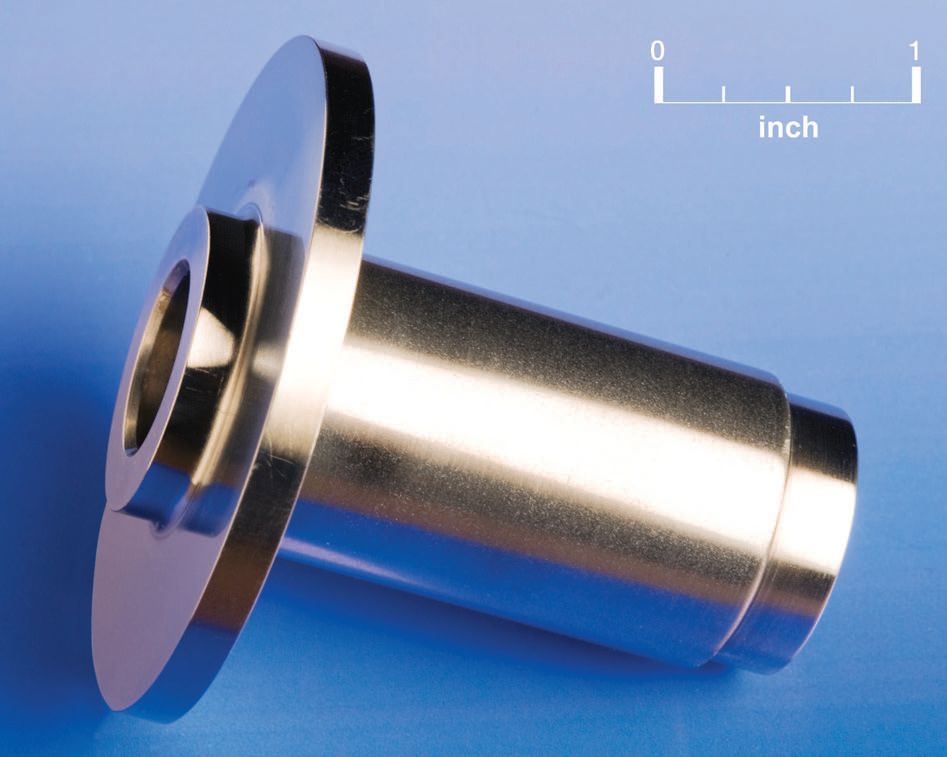New high-temperature solid lubricant coating
Dr. Neil Canter, Contributing Editor | TLT Tech Beat March 2016
Invented by NASA, PS400 exhibits superior dimensional and oxidation stability.
KEY CONCEPTS
•
NASA has developed PS400—a new solid lubricant composite coating based on a nickel-molybdenum-aluminum binder.
•
PS400 displays superior dimensional and oxidative stability based on tests in a hot section foil bearing.
•
Another PS400 benefit is that a reduction in the solid lubricant content from a previous solid lubricant coating leads to improved cost performance.
SOLID LUBRICANTS ARE USED IN EXTREME OPERATING APPLICATIONS where conventional liquid film lubricants cannot provide the lubricity, chemical resistance and corrosion protection required. Among the main types of solid lubricants are graphite, molybdenum disulfide and polytetrafluoroethylene.
But these traditional solid lubricants do not exhibit thermal and chemical stability under vacuum conditions, in atmospheric air and in hydrogen. A previous TLT article discusses a new technique for combining two or more solid lubricants to, it is hoped, maximize their benefits and minimize their deficiencies (
1). A heterostructure based on graphene and tungsten disulfide was prepared using a scotch-tape method that literally places one material on top of another.
Another approach that differs from the layered structure is to form composites by depositing coatings made from mixed materials.
STLE Fellow Dr. Christopher DellaCorte, senior technologist, Tribology and Rotating Machinery at NASA’s Glenn Research Center in Cleveland, says NASA has developed three distinct families of solid lubricant composite coatings since the 1970s. DellaCorte also is editor of Tribology Transactions, STLE’s peer-reviewed journal.
Says DellaCorte: “The first solid lubricant coating known as PS100 is based on a nickel chromium glass composite that is a soft coating, which was used successfully in the high temperature environment of turbine engines.”
But in the 1980s, a harder binder matrix material was required for use in the high-speed turbine engines. “At that time we developed a nickel-cobalt chrome carbide composite known as PS200 that proved to be effective but had problems with abrasion against soft-metal alloys,” says DellaCorte.
This led to the preparation of the third family known as PS300 that involved using an inexpensive nickel-chromium binder in combination with a chrome oxide hardener. DellaCorte says, “Chrome oxide is not as hard as the chrome carbide used in the second coating family enabling PS300 to be used with softer metals in turbocharger and turbine engine applications.”
But PS300 had some operating deficiencies that included a lack of dimensional stability.
Coatings prepared with PS300 also grew in thickness after 5,000 hours of operating life that unfortunately led to the jamming of clearances in some applications. Thickness levels increased by as much as 7% after exposure of the coating in air to temperatures in excess of 500 C.
DellaCorte says, “This problem was circumvented through 100 hours of heat treatment in air followed by a final grinding of the coating. But the need to do further processing added manufacturing cost and limited potential applications for PS300.”
A need existed for a fourth coating family to provide better performance than PS300. Such a solid lubricant coating now has been developed.
NICKEL MOLYBDENUM ALUMINUM BINDER
DellaCorte, in collaboration with Brian Edmonds, has now developed a fourth solid lubricant coating known as PS400 that exhibits superior dimensional and oxidation stability compared to PS300. “Incorporation of a nickel-molybdenum-aluminum binder in the coating leads to better creep resistance and an improved bonding to the substrate,” says DellaCorte. “Chrome oxide is included in the new solid lubricant coating to contribute strength and wear resistance. The final component is a eutectic mixture of barium fluoride and calcium fluoride blended with silver to act as high and low temperature solid lubricants, respectively.”
A common approach for preparing and applying the coating is thermal spray deposition. The individual components can be mixed as powders in a suitable container prior to spray deposition. Once a uniform mixture is achieved, the powder is injected into an argon gas carrier stream that is then subjected to ionized argon gas that provides the temperature needed to melt the powder. Application of the melted powder follows to produce a coating that has a typical thickness of 300 microns.
One of the additional benefits of PS400 is a reduction of the solid lubricant content from 10% to 5% compared to PS300. DellaCorte says, “The decrease in solid lubricant actually improves the new coating’s high temperature strength and could possibly improve its surface finish. The cost of the solid lubricant also is reduced without sacrificing performance. A high volume application can cut the cost of the solid lubricant powder by 20%.”
DellaCorte also points out that PS400 can be applied not only by thermal spray deposition but by all commercially available techniques. Tribological testing is conducted on the nickel-based superalloy, Inconel X-750. DellaCorte says, “This alloy is commonly used in foil gas bearings that are being tested in advanced oil-free turbomachinery systems.”
Evaluation of a PS400 shaft coating in a hot section foil bearing contained within a microturbine engine involved 2,200 start-up and shutdown cycles conducted over 8,000 hours of operation at 96,000 rpm and a temperature of 540 C. The shaft was then disassembled and inspected. DellaCorte says, “The coating changed in appearance to a smoothly polished surface that is ideal for strong tribological performance under these extreme temperature conditions. Improved wear performance also is observed as compared to PS300.”
Figure 1 shows an engine shaft from a Capstone Microturbine C30 engine coated with PS400 on the surface of the journal shaft.
 Figure 1. PS400 applied to the surface of the journal shaft from a Capstone Microturbine C30 engine provides superior dimensional and oxidative stability. (Figure courtesy of NASA.)
Figure 1. PS400 applied to the surface of the journal shaft from a Capstone Microturbine C30 engine provides superior dimensional and oxidative stability. (Figure courtesy of NASA.)
Besides foil bearings, DellaCorte envisions that PS400 can be used in high temperature components such as furnaces and conveyor bushings. He says, “We believe that PS400 represents a starting point for industrial applications and not the ultimate high temperature coating.”
DellaCorte indicates that NASA is interested in licensing the PS400 technology. He says, “Interested parties can contact Amy Hiltabidel, NASA technology manager at
amy.hiltabidel@nasa.gov.”
Additional information can be found in a past article2 or by contacting DellaCorte at
christopher.dellacorte@nasa.gov.
REFERENCES
1.
Canter, N. (2015), “Potential of van der Waals heterostructures as solid lubricants,”
TLT, 71 (2), pp. 10-11.
2.
DellaCorte, C. and Edmonds, B. (2009), “NASA PS400: A new high temperature solid lubricant coating for high temperature wear applications,” NASA/TM-2009-215678.
 Neil Canter heads his own consulting company, Chemical Solutions, in Willow Grove, Pa. Ideas for Tech Beat items can be sent to him at neilcanter@comcast.net
Neil Canter heads his own consulting company, Chemical Solutions, in Willow Grove, Pa. Ideas for Tech Beat items can be sent to him at neilcanter@comcast.net.